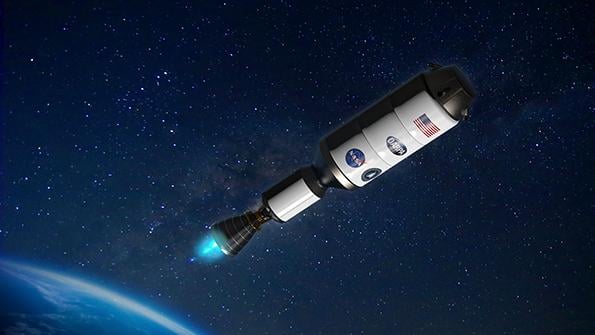Opinion: Invest In Technology To Make Deep Space Travel Feasible

The technological challenges of transporting crews to deep space draw many parallels with the obstacles at the beginning of the Age of Discovery. Much like those early journeys across oceans, mounting a crewed exploration into the Solar System is a monumental undertaking, requiring backing on a national scale. And brave crews must be willing to set out on an isolated journey lasting years and involving distances that are almost unfathomable.
As plans and resources are being marshaled now to make these first sojourns out into the greater Solar System, however, we can begin to wonder what will come after these first and important steps. The wooden-ship era eventually gave way to the steam engine and the turbofan. An individual can make a trip across the ocean in a matter of hours—on a flight with food, drink and internet—that took sailors months in the Age of Discovery. This invites the question regarding space: What new innovations in transportation technology could make traveling the Solar System a routine enterprise?
Innovation in deep space transportation beyond the Earth-Moon system must address two key challenges: the prohibitively long transit times for humans (years) and the staggeringly high propellant masses (think of a semitruck whose entire trailer is made of fuel). Near-term technical solutions for the propellant problem exist now. For example, for conventional chemical rockets with relatively low propellant efficiency (“gas mileage”), one strategy is to set up “gas stations” in orbit, where a spacecraft could refuel before transiting to deep space.
In some cases, gas stations might be built at the destination by harvesting propellant from the target body’s atmosphere or crust. An alternative and potentially more economical approach is to use propulsion options that have inherently higher gas mileage. Nuclear thermal propulsion, for example, can achieve the same overall impulse as chemical rockets but with a fraction of the propellant. Nuclear electric propulsion thrusters, which rely on electrical power from a nuclear reactor to energize and accelerate propellant, can provide an order of magnitude reduction in propellant mass.
Assuming we select an electric propulsion system to alleviate the propellant burden, transit time remains a major challenge. The key figure of merit for reducing transit time with an electric propulsion and power system is the overall specific mass: the system mass divided by the total power level. Smaller values of specific mass translate to more rapid acceleration for the vehicle and thus shorter transit times. If the propulsion and power specific mass can be lowered—some studies call for values less than 1 kg/kW at more than 10 megawatts of power—rapid acceleration and transits (such as 30 days to Mars) becomes possible. The challenge, though, is that even near-term projections have only 10 kg/kW for electric propulsion systems.
Achieving the necessary reduction in specific mass for the power and propulsion system will require major technical innovations. Key advances must include leap-forward advancements in subsystems such as lightweight materials for radiation shielding, novel methods of radiating waste heating, improved efficiencies of thermodynamic cycles, ultralightweight power management systems and high power-density engines. Efforts to realize these should be holistic as well, focusing on not only improving the mass of subsystems, but also integrating the power system and engine in novel ways.
Alternatives beyond nuclear power also should be explored. In principle, fusion rockets may offer both high thrust-to-weight and high propellant efficiency. Beamed power schemes could decouple the power system entirely from the spacecraft (resulting in an effective specific mass of 0). Using kilometer-wide laser arrays to beam megawatts of power to electric propulsion systems on the spacecraft, for example, could enable extremely rapid transits.
While several concepts have been proposed and some are under active investigation, a key question remains: What will fuel the innovation? Unlike the development of steamships and airplanes, which had obvious use cases beyond exploration, to what other use would spacecraft that could reach these distant and inhospitable destinations be put?
One might even argue that the reason we have not achieved the technological breakthroughs to enable rapid and convenient travel in the Solar System is a lack of urgency. Are there economic, political, or social gains to be had from easier transits throughout the Solar System? Will these only become manifest after we send our first expeditions across space? These are important questions and ones that should be part of the public discourse.
Encouragingly, the increased interest in cislunar space shown by NASA and the U.S. Defense Department is spurring new innovation in space transportation. In parallel, we need to continue to inspire creative solutions from academia and industry, growing a workforce of engineers and scientists who are aware of the challenges and eager to innovate.
Major innovations in technology have brought us a long away from the age of wooden ships to our current international transportation infrastructure. This could be the future of space as well. The technical challenges are clear, and there is no lack of exciting ideas to meet them. With the rapid pace of innovation in technology, maybe one day the trip to Mars or Ceres will be as routine as buying an airplane ticket.
Benjamin Jorns is an associate professor of aerospace engineering at the University of Michigan.
The views expressed are not necessarily those of Aviation Week.





Comments
In June 1969, men first landed on the Moon in the technological equivalent of a dogsled. We are still using dogsleds.